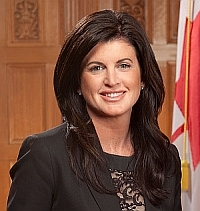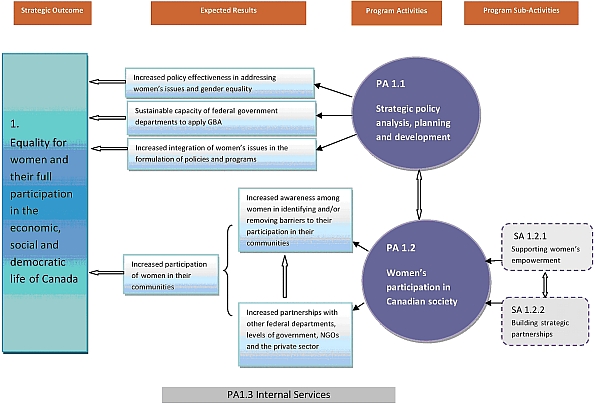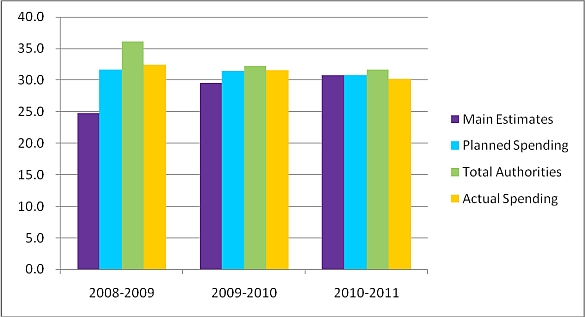Common menu bar links
Breadcrumb Trail
ARCHIVED - Status of Women Canada - Report
 This page has been archived.
This page has been archived.
Archived Content
Information identified as archived on the Web is for reference, research or recordkeeping purposes. It has not been altered or updated after the date of archiving. Web pages that are archived on the Web are not subject to the Government of Canada Web Standards. As per the Communications Policy of the Government of Canada, you can request alternate formats on the "Contact Us" page.
Minister’s Message
 As Minister for Status of Women, I am honoured to present Status of Women Canada’s 2010–2011 Departmental Performance Report.
As Minister for Status of Women, I am honoured to present Status of Women Canada’s 2010–2011 Departmental Performance Report.
Status of Women Canada continues to achieve concrete results for Canadians, advancing equality for women in three priority areas: ending violence against women and girls; improving women’s economic security and prosperity; and promoting women’s leadership and decision-making roles. It also continues to collaborate with a range of partners to fulfil its mandate and meet the Government of Canada’s priorities for women and girls.
Status of Women Canada’s achievements over the past year are significant. They include the Blueprint Projects initiative – an innovative response to the Government of Canada’s goal of streamlining practices and providing greater flexibility to community organizations. The Blueprint Projects are a series of ready-made project models that enable Canadian organizations to address pressing issues facing Canadian women and girls.
Status of Women Canada was also the lead in the collaborative effort across government to produce Statistics Canada’s sixth edition of Women in Canada. This invaluable resource provides key information on the situation of women in areas such as economic security, violence, access to education and career opportunities, and data on specific groups, such as immigrant and Aboriginal women.
Canada will play a lead role in advancing a United Nations Resolution to proclaim an International Day of the Girl. I obtained unanimous support from the House of Commons when I announced the news on International Women’s Day, celebrated in Canada under the theme “Girls’ Rights Matter.”
However, while there is progress in many areas, violence against women and girls – and certain groups in particular – persists. That is why, over the past year, we have placed particular emphasis on addressing the systemic roots of violence, including targeting the heightened vulnerability of Aboriginal women. For example, Status of Women Canada supported a variety of projects, such as those that empower immigrant girls and young women and address such issues as honour-related violence; reducing violence against Aboriginal women and strengthening their communities; and addressing safety and security concerns for women with disabilities.
I have seen first-hand the benefits that our efforts have achieved for women and girls, and I am confident that we will continue to see positive results for all Canadians. Together we can achieve our vision of a society in which women and men, boys and girls live free of violence, benefit equally from Canada’s economic prosperity and share fully in the leadership of our country.
Rona Ambrose, P.C., M.P.
Minister for Status of Women
Section I – Agency Overview
1.1 Raison d’�tre and Responsibilities
The Office of the Coordinator, Status of Women, became a departmental agency of the federal government on April 1, 1976. The legal mandate of Status of Women Canada is “to coordinate policy with respect to the status of women and administer related programs” (Policy authority – Order in Council 1976–779).
To fulfil this mandate, Status of Women Canada (SWC) works with partners such as federal departments and agencies, provincial/territorial governments, as well as members of the private and voluntary sectors. It also works with other key players to assist in meeting Canada’s international obligations.
In its strategic policy role, SWC fosters information exchange and collaborative interventions, and provides expert advice to federal organizations on long-standing and emerging issues, opportunities and best practices to help advance the full participation of women in Canadian society.
SWC leads the process of implementing gender-based analysis (GBA)1 by helping build organizational capacity, supporting federal organizations in their efforts to make GBA part of their regular practice and assisting in ensuring accountability for gender equality. For more information, see: Gender-based Analysis and Strategic Policy (http://www.swc-cfc.gc.ca/pol/gba-acs/index-eng.html).
SWC, through the Women’s Program, plays a vital role in supporting the work of women’s and other Canadian organizations to improve women’s economic and social conditions and to increase their participation in democratic life. These projects, many taking place at the community level, allow organizations with the relevant expertise to deliver projects that are appropriate to their communities. SWC continues to play a coordinating role among the organizations, encouraging partnerships where focus and approaches are similar. For more information, see: Funding (http://www.swc-cfc.gc.ca/fun-fin/wcf-fcf/index-eng.html).
In fulfilling its mandate, SWC takes into consideration the opportunities associated with Canada’s progress on advancing equality for women, while focusing its efforts where the need is greatest. As such, in 2010–2011, it maintained the three priority areas, ensuring its policy work and program investment are directed to those areas where gender equality gaps exist and paying particular attention to the challenges faced by women from diverse backgrounds.
SWC’s head office which also houses the Ontario regional office is located in the National Capital Region. Other regional offices are located in Moncton (for the Atlantic Region), Montreal (for Quebec and Nunavut) and Edmonton (for the West, Northwest Territories and Yukon). (http://www.swc-cfc.gc.ca/)
1.2 Strategic Outcome and Program Activity Architecture
The Program Activity Architecture (PAA) below displays SWC’s strategic outcome, expected results, program activities and sub-activities. As shown in the PAA, SWC has a single strategic outcome which is supported by the two program activities. As an inventory of activities, the PAA shows the relationship between the two program activities, the linkages between their expected results and how these results contribute to the agency’s strategic outcome. It also serves to report on how program activities are managed and resources invested to achieve long-term and enduring benefit for Canadians.

1.3 Organizational Priorities
| Priority | Type | Strategic Outcome |
|---|---|---|
| Strengthen implementation and use of gender-based analysis (GBA) | Ongoing | Equality for women and their full participation in the economic, social and democratic life of Canada |
| Status | ||
|
Met All
|
||
| Priority | Type | Strategic Outcome |
| Strategies to end violence against women and girls, including Aboriginal women and girls | Ongoing | Equality for women and their full participation in the economic, social and democratic life of Canada |
| Status | ||
|
Met All
|
||
| Priority | Type | Strategic Outcome |
| Financial and professional assistance for projects to address women’s economic security and encourage women in leadership roles | Ongoing | Equality for women and their full participation in the economic, social and democratic life of Canada |
| Status | ||
|
Met All
|
||
| Priority | Type | Strategic Outcome |
| Corporate Risk Profile | Previously committed | Equality for women and their full participation in the economic, social and democratic life of Canada |
| Values and Ethics | Previously committed | |
| Audit and Evaluation |
New |
|
| Status | ||
|
Mostly Met
|
||
1.4 Risk Analysis
Strategic Context
Although Canada is making considerable strides toward gender equality, particularly in areas such as the labour market2, workforce representation3, employment rate4 and entrepreneurship5, there are still areas where more work needs to be done. There are persistent gaps, for example, between women and men’s economic situation (e.g., wage gap, concentration in traditional jobs) and in their representation in leadership positions (where women remain under-represented). In addition, violence against women and girls continues to be a pressing health, social and criminal justice issue.
The existence of these gaps across social and economic domains reinforces the fact that the achievement of gender equality in Canada is a shared responsibility across federal departments and agencies, between various levels of government, and with different stakeholders, including civil society. For its part, SWC is focusing its efforts on addressing gaps specifically related to women’s economic security, promoting women in leadership positions and addressing key issues related to violence against women and girls.
Operating Environment
SWC undertook efforts to address challenges identified in the 2010–2011 Report on Plans and Priorities related to a corporate risk profile, values and ethics code, and audit and evaluation. Specifically, SWC completed an initial corporate risk profile (CRP) in 2010–2011 as well as a Values and Ethics Code for the organization. The audit and evaluation function has been strengthened while the summative evaluation of the Women’s Program will be completed in 2011–2012.
In 2010–2011, SWC’s operational and management priorities were implemented with measurable results, and potential risks were managed using various strategies. As SWC continues to develop its risk management capacity, the agency has ensured that risk is understood, communicated
and integrated in its decision-making processes and operational activities.
1.5 Summary of Performance
| Planned spending | Total authorities | Actual spending |
|---|---|---|
| 30.8 | 31.7 | 30.2 |
| Planned | Actual | Difference |
|---|---|---|
| 94 | 92 | 2 |
| Performance indicators | Targets | 2010–2011 Performance | ||||
|---|---|---|---|---|---|---|
| 1% increase per year |
In 2010–2011, SWC contributed to this strategic outcome: | |||||
| Representation of women in senior decision-making positions in the public and private sectors |
|
|||||
| Representation of women in the labour market, including access to support programs and services for entrepreneurship initiatives |
|
|||||
| Participation of women in political processes/systems at the local, provincial and federal levels |
|
|||||
| The 2010–2011 performance analysis shows steady progress toward this strategic outcome, as demonstrated by the gains made in women’s representation in the labour market, workforce and women’s participation in leadership and decision making roles. However, gender equality gaps persist in key areas. While this
strategic outcome cannot be achieved solely by SWC, the agency continues to contribute toward its realization through its two program activities. |
||||||
| Program activity | ($ millions) | Alignment to Government of Canada outcomes |
||||
| 2009 –10 Actual spend- ing |
2010–20116 | |||||
| Main esti- mates |
Plan- ned spend- ing |
Total author- ities |
Actual spend- ing |
|||
| Strategic policy analysis, planning and development | 1.6 | 1.8 | 1.8 | 2.1 | 2.0 | Government Affairs |
| Women’s participation in Canadian society | 23.4 | 25.1 | 25.1 | 25.4 | 22.7 | Economic Affairs |
| Total | 25.0 | 26.9 | 26.9 | 27.5 | 24.7 | |
| Program activity | ($ millions) | |||||
| 2009 –10 Actual spend- ing |
2010–2011 | |||||
| Main esti- mates |
Plan- ned spend- ing |
Total author- ities |
Actual spend- ing |
|||
| Internal services | 6.6 | 3.9 | 3.9 | 4.2 | 5.5 | |
In comparison with Planned Spending, the increase in Total Authorities is explained by the inclusion of the 2009–2010 operating budget carry forward, paylist expenditures, funding received through the Supplementary Estimates B and the Employee Benefit Plan adjustment.
The difference between total authorities and actual spending includes $448 thousand in frozen allotments which represents funds withheld by Treasury Board and which cannot be spent by Status of Women Canada.
1.6 Expenditure Profile
Departmental Spending Trend
In 2010–2011 SWC spent a total of $30.2 million to carry out its program activities, to achieve expected results and to advance toward its planned strategic outcome.
The increases in Main Estimates are due to additional grant and contribution funding from Budget 2007 and re-profiled funding from 2008–2009.
The decrease in total authorities is due to the sunsetting of a re-profiled grant and contribution funding.
Spending Trend ($ millions)

1.7 Estimates by Vote
For information on SWC’s votes and/or statutory expenditures, please see the 2010–2011 Public Accounts of Canada (Volume II) publication which is available at: http://www.tpsgc-pwgsc.gc.ca/recgen/txt/72-eng.html.
